Levosimendan attenuates multiple organ injury and improves survival in peritonitis-induced septic shock: studies in a rat model
- PMID: 25432865
- PMCID: PMC4274679
- DOI: 10.1186/s13054-014-0652-4
Levosimendan attenuates multiple organ injury and improves survival in peritonitis-induced septic shock: studies in a rat model
Abstract
Introduction: The aim of this study was to investigate the effects of levosimendan on rodent septic shock induced by cecal ligation and puncture (CLP).
Methods: Three hours after peritonitis-induced sepsis, male Wistar rats were randomly assigned to receive an intravenous infusion of levosimendan (1.2 μg/kg/min for 10 min and then 0.3 μg/kg/min for 6 h) or an equivalent volume of saline and vehicle (5% dextrose) solution.
Results: The levosimendan-treated CLP animals had significantly higher arterial pressure and lower biochemical indices of liver and kidney dysfunction compared to the CLP animals (P < 0.05). Plasma interleukin-1β, nitric oxide and organ superoxide levels in the levosimendan-treated CLP group were less than those in CLP rats treated with vehicle (P < 0.05). In addition, the inducible nitric oxide synthase (iNOS) in lung and caspase-3 expressions in spleen were significantly lower in the levosimendan-treated CLP group (P < 0.05). The administration of CLP rats with levosimendan was associated with significantly higher survival (61.9% vs. 40% at 18 h after CLP, P < 0.05). At postmortem examination, the histological changes and neutrophil filtration index in liver and lung were significantly attenuated in the levosimendan-treated CLP group (vs. CLP group, P < 0.05).
Conclusions: In this clinically relevant model of septic shock induced by fecal peritonitis, the administration of levosimendan had beneficial effects on haemodynamic variables, liver and kidney dysfunction, and metabolic acidosis. (1) Lower levels of interleukin-1β, nitric oxide and superoxide, (2) attenuation of iNOS and caspase-3 expressions, and (3) decreases of neutrophil infiltration by levosimendan in peritonitis-induced sepsis animals suggest that anti-inflammation and anti-apoptosis effects of levosimendan contribute to prolonged survival.
Figures
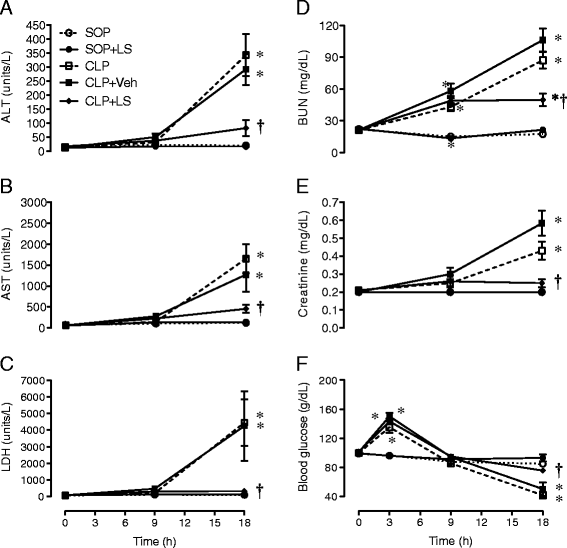
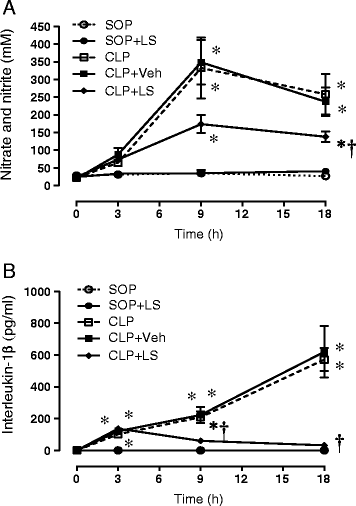

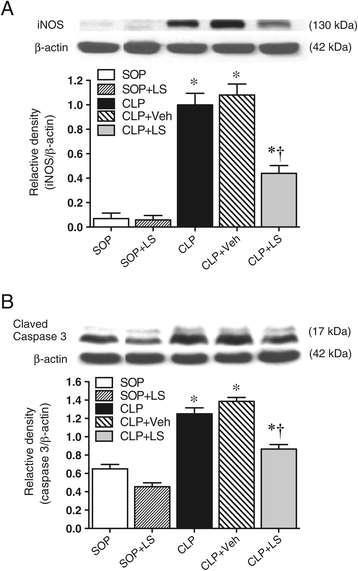
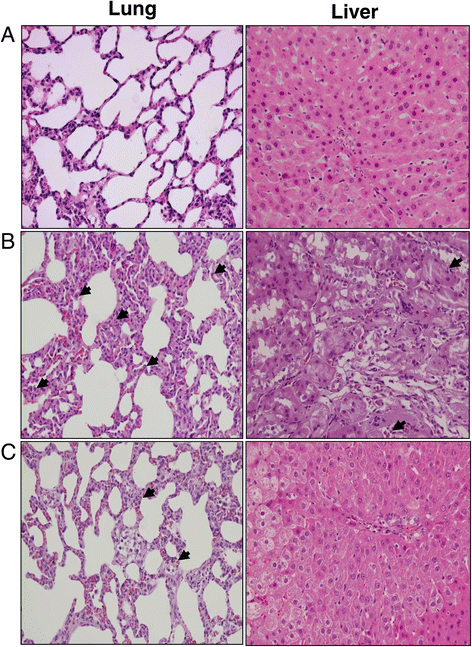
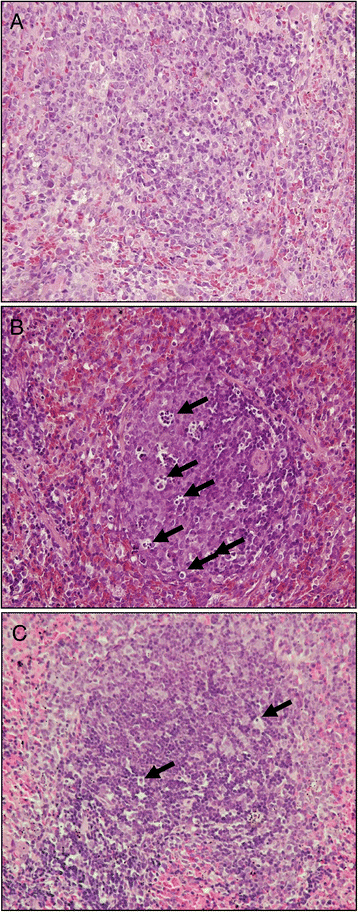
Similar articles
-
Therapeutic effects of hypertonic saline on peritonitis-induced septic shock with multiple organ dysfunction syndrome in rats.Crit Care Med. 2008 Jun;36(6):1864-72. doi: 10.1097/CCM.0b013e318173f982. Crit Care Med. 2008. PMID: 18496380
-
Effects of terbutaline on circulatory failure and organ dysfunction induced by peritonitis in rats.Intensive Care Med. 2010 Sep;36(9):1571-8. doi: 10.1007/s00134-010-1839-z. Epub 2010 Mar 11. Intensive Care Med. 2010. PMID: 20221745
-
Therapeutic effects of melatonin on peritonitis-induced septic shock with multiple organ dysfunction syndrome in rats.J Pineal Res. 2008 Aug;45(1):106-16. doi: 10.1111/j.1600-079X.2008.00567.x. Epub 2008 Feb 19. J Pineal Res. 2008. PMID: 18298464
-
Role of levosimendan in sepsis and septic shock.Curr Opin Anaesthesiol. 2008 Apr;21(2):168-77. doi: 10.1097/ACO.0b013e3282f43c56. Curr Opin Anaesthesiol. 2008. PMID: 18443483 Review.
-
Rodent models of intra-abdominal infection.Shock. 2005 Dec;24 Suppl 1:19-23. doi: 10.1097/01.shk.0000191386.18818.0a. Shock. 2005. PMID: 16374368 Review.
Cited by
-
Levosimendan Efficacy and Safety: 20 years of SIMDAX in Clinical Use.Card Fail Rev. 2020 Jul 8;6:e19. doi: 10.15420/cfr.2020.03. eCollection 2020 Mar. Card Fail Rev. 2020. PMID: 32714567 Free PMC article. Review.
-
[Heart in sepsis : Molecular mechanisms, diagnosis and therapy of septic cardiomyopathy].Anaesthesist. 2017 Jul;66(7):479-490. doi: 10.1007/s00101-017-0329-x. Anaesthesist. 2017. PMID: 28677016 Review. German.
-
Tissue heme oxygenase-1 exerts anti-inflammatory effects on LPS-induced pulmonary inflammation.Mucosal Immunol. 2016 Jan;9(1):98-111. doi: 10.1038/mi.2015.39. Epub 2015 May 6. Mucosal Immunol. 2016. PMID: 25943274
-
Preclinical septic shock research: why we need an animal ICU.Ann Intensive Care. 2019 Jun 10;9(1):66. doi: 10.1186/s13613-019-0543-6. Ann Intensive Care. 2019. PMID: 31183570 Free PMC article. Review.
-
When sepsis affects the heart: A case report and literature review.World J Clin Cases. 2015 Aug 16;3(8):743-50. doi: 10.12998/wjcc.v3.i8.743. World J Clin Cases. 2015. PMID: 26301236 Free PMC article.
References
-
- Ani C, Farshidpanah S, Bellinghausen Stewart A, Nguyen HB: Variations in Organism-Specific Severe Sepsis Mortality in the United States: 1999-2008.Crit Care Med 2014, in press. - PubMed
-
- ProCESS Investigators. Yealy DM, Kellum JA, Huang DT, Barnato AE, Weissfeld LA, Pike F, Terndrup T, Wang HE, Hou PC, LoVecchio F, Filbin MR, Shapiro NI, Angus DC. A randomized trial of protocol-based care for early septic shock. N Engl J Med. 2014;370:1683–1693. doi: 10.1056/NEJMoa1401602. - DOI - PMC - PubMed
-
- Zhou J, Qian C, Zhao M, Yu X, Kang Y, Ma X, Ai Y, Xu Y, Liu D, An Y, Wu D, Sun R, Li S, Hu Z, Cao X, Zhou F, Jiang L, Lin J, Mao E, Qin T, He Z, Zhou L, Du B, China Critical Care Clinical Trials Group (CCCCTG) Epidemiology and outcome of severe sepsis and septic shock in intensive care units in mainland china. PLoS One. 2014;9:e107181. doi: 10.1371/journal.pone.0107181. - DOI - PMC - PubMed
-
- Trzeciak S, Cinel I, Phillip Dellinger R, Shapiro NI, Arnold RC, Parrillo JE, Hollenberg SM, Microcirculatory Alterations in Resuscitation and Shock (MARS) Investigators Resuscitating the microcirculation in sepsis: the central role of nitric oxide, emerging concepts for novel therapies, and challenges for clinical trials. Acad Emerg Med. 2008;15:399–413. doi: 10.1111/j.1553-2712.2008.00109.x. - DOI - PMC - PubMed
Publication types
MeSH terms
Substances
LinkOut - more resources
Full Text Sources
Other Literature Sources
Research Materials
Miscellaneous

